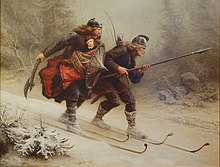American Birkebeiner

American Birkebeiner je lyžařský maraton pořádaný každoročně v národním lese Chequamegon-Nicolet v severozápadním Wisconsinu. Jedná se o největší závod v běhu na lyžích v Severní Americe, jehož trasa měří 51 km.
Závod vznikl v roce 1973 a je zařazen do světové ligy dálkových běhů Worldloppet.
Původ názvu
Maraton svým názvem připomíná hrdinství skupinky norských vojáků známých jako birkebeinerové či březonozí (protože si obalovali nohy březovou kůrou), kteří za norské občanské války v roce 1206 zachránili nemanželského syna krále Hakona III. tím, že jej na lyžích dopravili z Lillehammeru do Trondheimu. Zachránili mu tak život a umožnili mu stát se příštím králem Hakonem IV.
Běh se koná poslední víkend v únoru.
